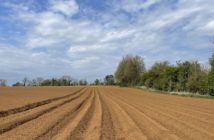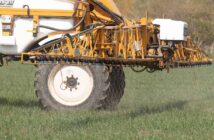Damage to legume crops from pea and bean weevil and field thrips has been reported in the last few weeks. Cool, dry spring weather has led to slow crop development and as a result, damage has been severe in some cases.
Field thrips
Early spring-sown crops, particularly those on stony, calcareous soils, are more prone to damage from thrips. Many generations of thrips are wingless and spend most of the year in the soil, feeding on a wide range of non-legume crops including Brassicas, linseed and sugar beet. As peas or beans begin to emerge in the spring, thrips feed inside the rolled leaves of the growing point. Because feeding causes damage to the leaf surface, young leaflets appear pale and slightly distorted and small translucent markings are visible. On beans, leaves may appear shiny and speckled with sooty black markings. The undersides of bean leaves develop a rusty brown discolouration. By carefully unfolding the leaflets of affected seedlings, thrips may be found.
In many situations, peas and beans can outgrow the initial attack, with no long-term effects on the crop. However, occasionally when the attack is severe, peas may develop multiple secondary shoots and develop as small bushy young plants. Bean leaves may die off completely and severely arrest the growth for a week or two. Where damage is noted in most years, then treatment can be justified.
Thrips in peas may be difficult to control as the insects feed inside the enclosed shoots. PGRO trials have shown that lambda-cyhalothrin has given a useful and consistent reduction of leaf damage. The active substance is approved for use on all peas for weevil control. Early treatment is essential and where thrips damage is confirmed as the peas are just emerging, and before the leaves have expanded, a single spray should be applied as soon as possible.
In beans, the thrips feed on the leaf surface and are often more exposed. In this case, a contact insecticide applied for weevil control will provide adequate control of thrips. It is seldom necessary to treat winter field beans.
Post-emergence herbicides
Some spring crops of peas and beans may be ready for post-emergence herbicide applications. Bentazone is the only active ingredient available in beans for post-emergence broad-leaved weed control. Bentazone and MCPB are both options in peas. The maximum permissible dose rate of Basagran SG is 1.1kg/ha in both peas and beans and split applications are permitted. There are various generic bentazone products available which generally can be used at a maximum 3.0 l/ha but no split applications are permitted in peas with these. The option of two low dose applications can be very effective on small susceptible weeds but fitting two applications in within the permitted application window may be difficult.
Tank mixes of Basagran SG + MCPB for peas are still supported as are mixes of MCPB with alternative bentazone products.
Note that post-emergence use of MCPB herbicides are not permitted on pea crops that are destined for seed.
Using bentazone when temperatures are low can give disappointing results. However, high temperatures shortly after application (> 20-21°C) can cause increased crop damage.




